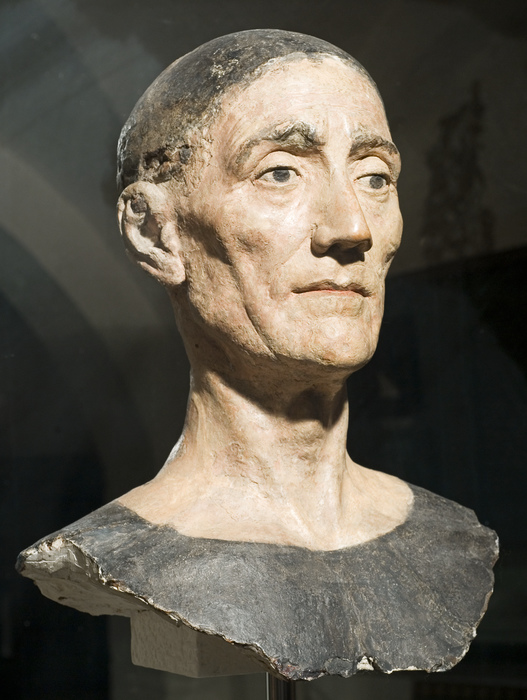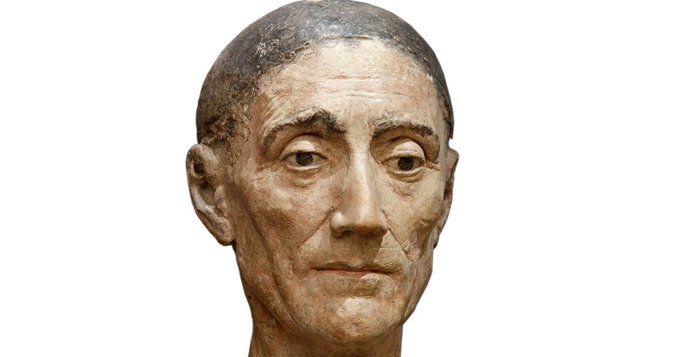The head from Henry VII’s funeral effigy stands as one of the finest surviving examples of royal portraiture from Renaissance England. Crafted with exceptional detail, it reflects the growing sophistication in artistic depictions of monarchs during the late 15th and early 16th centuries. This lifelike effigy is not only a remarkable work of art but also a powerful symbol of the monarch’s enduring legacy, blending realism with the grandeur of the Tudor monarchy.
The Role of Effigies in Royal Funerals
From the 14th to the 17th centuries, funeral effigies played a central role in the royal funerary rites of England. These effigies, life-size representations of the deceased monarch, were carried in funeral processions atop a catafalque, a raised platform. Their purpose was both ceremonial and symbolic: they ensured the continued presence of the king or queen, asserting the continuity of their reign even after death. These effigies were often crafted with extraordinary care to closely resemble the deceased, showcasing the monarch’s likeness in both physical and symbolic terms. Henry VII’s effigy, with its distinctive facial features, marked a departure from earlier, more stylized depictions of rulers, signifying a shift towards greater realism.

Craftsmanship and Material
The craftsmanship of Henry VII’s effigy head reveals a fascinating evolution in funerary art. Carved from wood and overlaid with a thin layer of wax, the head was designed to capture lifelike details with remarkable precision. This technique allowed artists to replicate skin tones and facial features with unparalleled realism, elevating the effigy from a mere symbol of death to a representation of the deceased monarch’s persona. The use of fine pigments to enhance the effigy further emphasized its lifelike qualities. The innovation of incorporating wax in the effigy-making process was groundbreaking for the period, setting a new standard for how royals would be represented in death.

Preservation and Historical Insights
The survival of Henry VII’s effigy head provides us with an invaluable glimpse into Tudor-era artistry and royal rituals. While many funeral effigies were lost, destroyed, or repurposed over the centuries, this head has endured as a testament to its exceptional craftsmanship. Today, it is housed in Westminster Abbey, where it remains one of the few surviving effigies from this period. Its preservation offers historians and art enthusiasts alike the rare opportunity to study the techniques and materials used in royal funerary art, as well as the social and political significance of royal portraiture during the Tudor period.
Cultural and Artistic Legacy
Beyond its immediate function as a funeral monument, Henry VII’s effigy head has played an important role in shaping the visual identity of the Tudor dynasty. The lifelike, realistic portrayal of Henry VII helped reinforce his image as a legitimate ruler, particularly as the Tudor family sought to establish their authority after Henry’s victory in the Wars of the Roses. Through such portrayals, the monarchy sought to assert its power and authority, ensuring that the memory of the monarch would be preserved for posterity. This effigy stands as a bridge between the medieval traditions of idealized portraiture and the Renaissance emphasis on individualism and realism.
The head from Henry VII’s funeral effigy is thus not just a work of art; it is an artifact that reflects the complex interplay between politics, art, and identity in Renaissance England. It provides a tangible connection to the past, helping us understand how the visual representation of monarchy evolved during a transformative period in English history. Its historical significance extends far beyond its role in the funeral of Henry VII, offering insights into the changing nature of royal representation and the enduring legacy of the Tudor dynasty.


